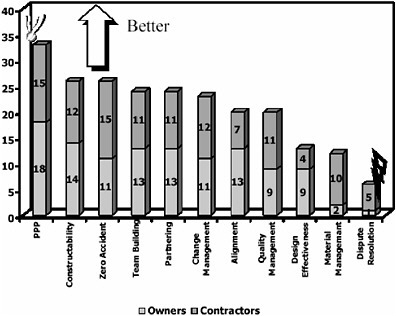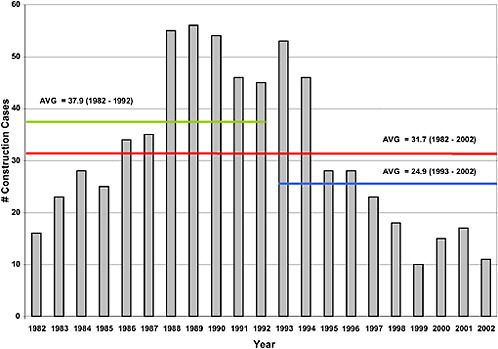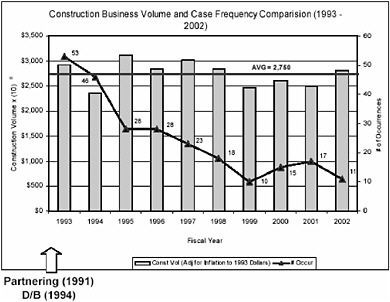9
Exploring Ways to Encourage and Implement Greater Uses of Dispute Resolution Best Practices
Summary of a Presentation by G. Edward Gibson
Director, Center for Construction Industry Studies, University of Texas
The construction industry needs viable dispute resolution methods because “if your only tool is a hammer, then every problem will look like a nail.” In other words, if the construction industry’s main dispute resolution tool is a lawyer, every disagreement looks like a lawsuit.
There are many processes, preventative practices, and alternative dispute resolution techniques available to owners, contractors, and other industry participants, but these methods are not widely used. The biggest obstacle has been lack of data. The research program of the Center for Construction Industry Studies (CCIS) at the University of Texas was established to provide some of the required data.
The CCIS was founded in 1996 with a major grant from the Alfred P. Sloan Foundation and with support from other organizations. The center is “dedicated to gaining a comprehensive understanding of the construction industry and to assuring its future competitiveness and advancement in a rapidly changing global environment.” One of the CCIS research thrust areas is economic, financial and dispute resolution (EFDR). EFDR research objectives are the following: assessing changes on a variety of issues—claims avoidance, alternative dispute resolution, changing owner/contractor relationships, and risk mitigation for project ventures; determining the effects of changes and processes on the cost and delivery of constructed facilities; and developing responsive policy statements directed at professionals working in the industry.
The Center studies economics, finance, and dispute resolution because there is tremendous interest from the construction professionals who are operating in this rapidly changing environment. Industry issues include project financing methods in the wake of the Enron collapse; the impact of the September 11, 2001, attacks on insurance, surety, and international ventures; and an increase in litigation, either real or perceived. Research on these types of EFDR issues can provide valuable information to industry decision makers.
To date, CCIS has studied owner and contractor relationships, organizational change, the loss of capabilities among owners and contractors, the legal implications of design/build contracting, and risk assessments on international projects.
One study focused on construction claims within the Naval Facilities Engineering Command (NAVFAC) between 1982 and 2002. During that period, 666 claims went before the Armed Services Board of Contract Appeals (Figure 9.1).
The study revealed that claims decreased significantly after 1992, from an average of 38 cases per year to an average of 25, even though the volume of work remained relatively constant-about $2.7 billion dollars of construction work annually, on average, and adjusted for inflation. The drop in claims occurred as NAVFAC implemented partnering processes (in 1991) and the use of design/build contracting (in 1994) (Figure 9.2).
Although we can not say that implementing partnering and design-build led directly to a decrease in claims, these were the two major changes that NAVFAC made in the way that they approached work in this time period.
In seeking the reason for the claims, CCIS found that, on the government side, project management procedures and poor communication were often cited. On the contractor side, contract interpretation, project management, and communication were cited as reasons.
A 2003 CCIS workshop in Texas helped identify specific research investigation that would benefit the industry in the areas of economics, finance, and dispute resolution. Three top research priorities emerged:
-
Investigate and document the transactional costs of dispute resolution through the progression of the dispute.
-
Identify up-front programming, planning, and design phase process improvements to reduce and manage disputes.
-
Quantify the benefits of using techniques designed to reduce and eliminate the costs of disputes.
CCIS did some preliminary work on the first priority area, transactional costs. Transactional costs were defined as those costs resulting from disputes, not including money paid out at settlement. Direct costs include fees and expenses paid to lawyers, paralegals, accountants, claims consultants, and other experts. Indirect costs are salaries and the associated overhead of in-house lawyers, company managers, and other employees involved in processing the dispute. Hidden costs are inefficiencies, delays, loss of quality to the project, and the cost of strained business relationships among the various parties.
A preliminary study to validate the methodology was completed. This preliminary study included 25 projects with a total installed cost of $690 million. Thirteen of the projects were public sector and 12 were private sector. These projects had claims totaling $147 million, which were eventually settled for $34 million. The transactional costs involved in reaching settlement totaled $18 million. For individual projects the transactional costs ranged from less than 2 percent to almost 200 percent of the original claim amount. These results cannot be considered final or complete but they are certainly interesting and bear additional research.
Several years ago when I served on the Construction Industry Institute’s (CII) Implementation Strategy Committee, we developed a model and mechanism for measuring the implementation of practices. We then studied the implementation of CII best practices among CII members. Forty-one companies responded and the results are captured in Figure 9.3.
Pre-project planning (shown far left) was used by more than 75 percent of the responding companies, while partnering was used by more than half. Dispute resolution, in contrast, was used by only 6 of 41 responding companies.
As part of the same study, we looked at drivers of implementation of best practices. The most significant drivers were support from top management, corporate commitment of resources needed to drive implementation, and a corporate implementation champion.

FIGURE 9.3 CII best practices usage among owners and contractors (sorted by popularity).
Other factors that were key for implementing practices successfully included:
Resources
-
Provide adequate resources in a timely manner
-
Use incentives to drive implementation
-
Develop tools to improve implementation
Measurement
-
Measure degree and impact of implementation
-
Analyze data to take actions
Documentation
-
Document self-auditing results
-
Document implementation goals and plans
Self-auditing Capability
-
Audit organizational implementation on a regular basis
-
Track degree of implementation
-
Document findings
These results raise an important question: Why are dispute resolution best practices not used more widely? There appear to be a number of reasons, including: lack of knowledge about options; lack of experience in using these tools; comfort with standardized contract language and discomfort with change; resistance to change in the way things are done from project and legal teams; and a belief that “it won’t happen to my project.”
Despite these obstacles, there is clear evidence that dispute resolution practices work. To adopt effective dispute resolution practices, the construction industry needs to raise awareness among organizations, allocate resources for dispute resolution, educate project teams and legal departments, and develop appropriate contract clauses. Furthermore, organizations need to see measurable results as well as successful case studies to gain confidence in new practices and policies.
RESOURCE
Center for Construction Industry Studies (CCIS). Available online at www.ce.utexas.edu/org/ccis/.








